In this comprehensive guide, we will explore everything you need to know about hydraulic hose couplings, including their types, factors to consider when choosing them, installation techniques, maintenance tips, and best practices for extending their lifespan.
Hydraulic hose couplings play a vital role in connecting hydraulic hoses to various hydraulic components, such as pumps, valves, cylinders, and motors. They provide a secure and leak-free connection, allowing hydraulic fluid to flow smoothly within the system. A well-designed and properly installed hydraulic hose coupling ensures optimal performance and safety in hydraulic applications.
What is a Hydraulic Hose Coupling?
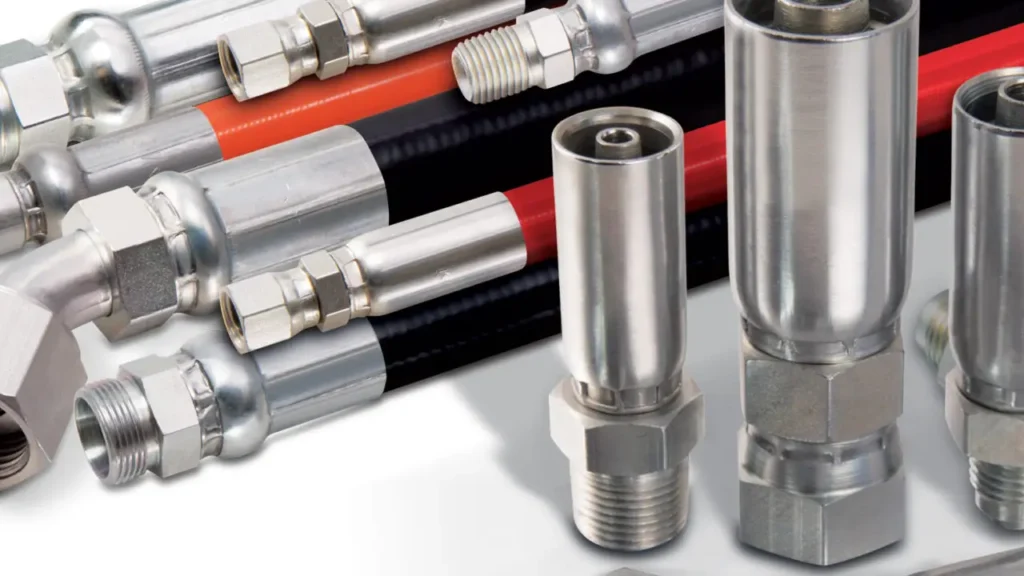
A hydraulic hose coupling is a mechanical device that connects two hydraulic hoses or a hose to a hydraulic component.
It consists of two main parts: the male end, which typically has external threads, and the female end, which has internal threads. When the male and female ends are connected, they create a sealed joint that allows hydraulic fluid to pass through.
What are Hydraulic Hose Couplings Made of?
Hydraulic hose couplings are primarily made from durable metals and, in some cases, plastics, chosen for their ability to withstand the high pressures, temperatures, and corrosive fluids found in hydraulic systems. The specific material selected depends on the application’s demands, balancing factors like strength, corrosion resistance, and cost.
Common materials include:
- Carbon Steel: A popular choice for its high tensile strength, durability, and resistance to heat. It is often coated with materials like zinc to enhance its resistance to corrosion.
- Stainless Steel: Known for exceptional corrosion resistance, making it ideal for harsh environments like marine settings or where corrosive chemicals are present. It also handles high temperatures and pressures but is typically more expensive than carbon steel.
- Brass: An alloy of copper and zinc that provides good corrosion resistance, especially to saltwater, and is relatively easy to machine. It’s often used in moderate-pressure applications.
- Aluminum: Chosen for its low density and high strength-to-weight ratio, which makes it lightweight. It is highly corrosion-resistant and is commonly used in aerospace and automotive industries for low-to-medium-pressure applications.
- Plastic: While less common for high-pressure systems due to lower physical strength, certain plastics offer high corrosion resistance and are used in low-pressure applications.
Hydraulic Hose Coupling Types
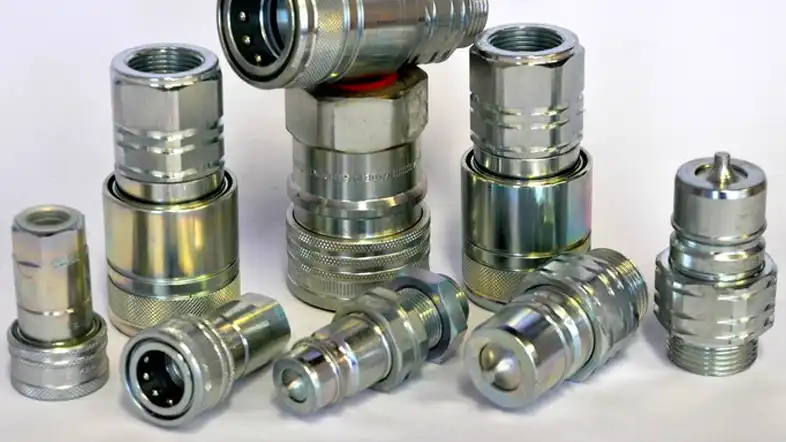
Screw-Type Couplings
Screw-type couplings are the most common type of hydraulic hose couplings. They feature threads on both the male and female ends, allowing for a secure and tight connection. Screw-type couplers are further classified into various subtypes, such as straight thread, tapered thread, and parallel thread couplings.
Quick Disconnect Couplings
Quick disconnect couplings, also known as quick couplers or quick release couplers, offer a convenient and fast way to connect and disconnect hydraulic hoses. They consist of two parts: the male and female halves, which can be easily joined or separated with a simple push or pull motion. Quick disconnect couplings are commonly used in applications where frequent hose connections and disconnections are required.
Flange Couplings
Flange couplings provide a robust and high-pressure connection between hydraulic hoses and components. They consist of a flat plate or mating flanges with bolt holes. When the flanges are bolted together, they create a strong and leak-free connection. Flange couplings are often used in heavy-duty applications that require high-pressure and large-diameter hoses.
Push-to-Connect Couplings
Push-to-connect couplings, also known as non-spill couplings, offer a simple and reliable method of connecting hydraulic hoses. They feature a push-button mechanism that allows for quick and easy connections without the need for additional tools. Push-to-connect couplings are commonly used in applications where ease of use and efficiency are essential.
Hydraulic Hose Quick Coupler

A hydraulic hose quick coupler, also known as a quick disconnect or hydraulic hose quick release coupling, is a device used to connect and disconnect hydraulic hoses quickly and easily.
It provides a secure and leak-free connection between two hydraulic components, such as hoses, cylinders, valves, or pumps.
The main purpose of a hydraulic hose quick coupler is to facilitate efficient and convenient hose changes, allowing for rapid assembly or disassembly of hydraulic systems.
It eliminates the need for time-consuming and potentially messy threaded connections, reducing downtime during maintenance or equipment setup.
Here are some key features and benefits of hydraulic hose quick couplers:
- Easy Connection and Disconnection: The quick coupler enables fast and effortless connection and disconnection of hydraulic hoses. It typically involves a simple push-pull or twist mechanism that securely locks the coupling in place.
- Leak-Free Operation: When properly engaged, hydraulic quick couplers provide a reliable and leak-free connection. This ensures the integrity of the hydraulic system and prevents fluid leakage, which can lead to performance issues or environmental concerns.
- Versatility: Hydraulic quick couplers are available in various sizes, configurations, and materials to accommodate different hydraulic applications. They can be designed for specific pressure ratings, flow rates, and compatibility with different hydraulic fluids.
- Safety Features: Many hydraulic quick couplers incorporate safety features to prevent accidental disconnection, such as locking mechanisms or visual indicators to confirm a secure connection. This helps protect operators and equipment from potential hazards.
- Durability and Longevity: Quick couplers are typically constructed from robust materials, such as steel, brass, or stainless steel, to withstand the high pressures and demanding operating conditions of hydraulic systems. They are designed to provide reliable performance and have a long service life.
- Time and Cost Savings: The ability to quickly connect and disconnect hydraulic hoses translates into significant time savings during equipment setup, maintenance, or repairs. This can reduce labor costs and improve overall productivity.
It’s important to select the appropriate quick coupler for your specific hydraulic system, considering factors such as flow requirements, pressure ratings, and compatibility with the hydraulic fluid being used. Regular inspection and maintenance of quick couplers are also essential to ensure their proper functioning and prevent any potential issues.
Hydraulic hose quick couplers are valuable components that enhance the efficiency, convenience, and safety of hydraulic systems by simplifying hose connections and disconnections.
Factors to Consider When Choosing Hydraulic Hose Couplings
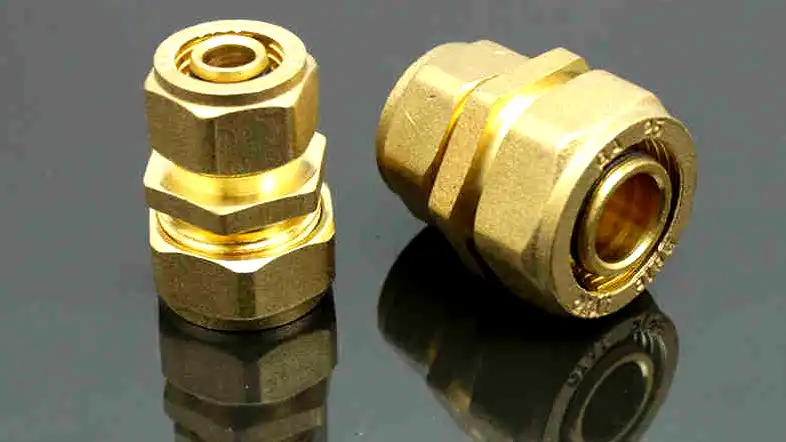
When selecting hydraulic hose repair couplings, several factors need to be taken into account to ensure compatibility and optimal performance. Here are some key factors to consider:
Pressure Rating
The pressure rating of the hydraulic hose coupling should match or exceed the maximum operating pressure of the hydraulic system. Choosing a coupling with a lower pressure rating can lead to leaks and system failure, while opting for a coupling with a higher pressure rating than necessary may result in unnecessary costs.
Hose Compatibility
It is crucial to ensure that the hydraulic hose coupling is compatible with the specific type of hose being used. Factors such as hose material, size, and end fittings should be considered to ensure a proper fit and reliable connection. Using incompatible couplings can lead to leaks, hose damage, and decreased system performance.
Size and End Fittings
The size of the hydraulic hose and the corresponding end fittings should be carefully matched to achieve a secure and leak-free connection. Choosing the wrong size or type of end fittings can result in improper sealing, reduced flow rate, and increased risk of failure.
Application Requirements
Consider the specific requirements of the hydraulic system, such as temperature range, chemical compatibility, and environmental conditions. Selecting a hydraulic hose coupling that meets these requirements will ensure optimal performance and longevity.
How to Install Hydraulic Hose Couplings?
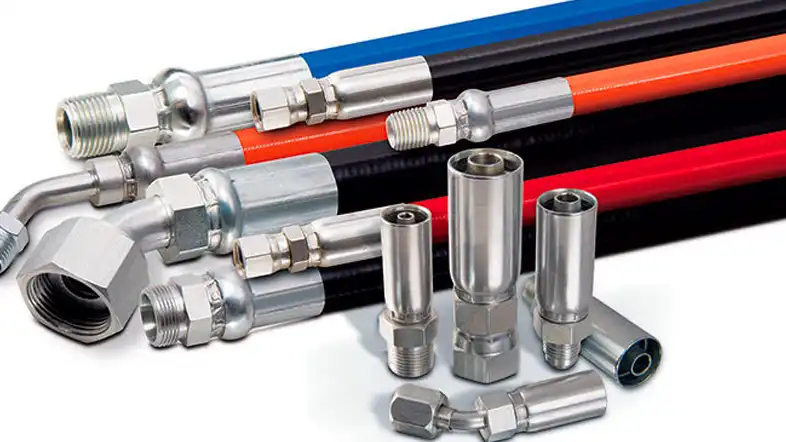
Installing hydraulic hose couplings is a precise process that requires the right tools and attention to detail. Proper installation ensures the integrity and safety of the hydraulic system, preventing leaks and potential failures under high pressure.
Step 1: Preparation
Before you begin, inspect the hydraulic hose and coupling to ensure they are clean, free of damage, and the correct size. Measure and mark the cut length of the hydraulic hose, adding the length of the coupling’s insert to ensure proper fitting. Use a specialized hydraulic hose cutter to make a clean, square cut, as a jagged cut can compromise the seal.
The hydraulic hose must be cut precisely to length and the outer cover must be skived off if required by the coupling type. Use the correct skiving tool to remove only the specified length of the outer cover, exposing the reinforcement wire underneath. This prepares the hydraulic hose for a secure crimp and a proper fit into the coupling.
Step 2: Coupling Assembly
Lubricate the inside of the hydraulic hose and the coupling’s insert to make it easier to push the coupling on. Push the coupling insert fully into the hydraulic hose until the hydraulic hose end is flush with the coupling’s collar. This step is critical to ensure the coupling is seated correctly and will create a secure, leak-proof connection after crimping.
The coupling should be firmly in place, so the hydraulic hose does not slip off the insert. You can visually inspect the assembly to ensure it is properly aligned and there are no gaps. This prepares the hydraulic hose and coupling for the final, most crucial step of the installation process, which is the crimping.
Step 3: Crimping
Place the hydraulic hose assembly into the crimping machine, aligning the collar with the crimper’s dies. The crimp must be done with the correct dies for the hydraulic hose and coupling, and the crimp diameter must be set to the manufacturer’s specification. An undersized or oversized crimp will not provide a secure fit and can lead to failure.
Once the crimp is complete, remove the assembly and measure the crimp diameter at multiple points to ensure it meets the manufacturer’s specifications. A final inspection for any signs of damage or improper crimping ensures the hydraulic hose assembly is safe and ready for use in a high-pressure environment.
Maintenance Tips for Hydraulic Hose Couplings
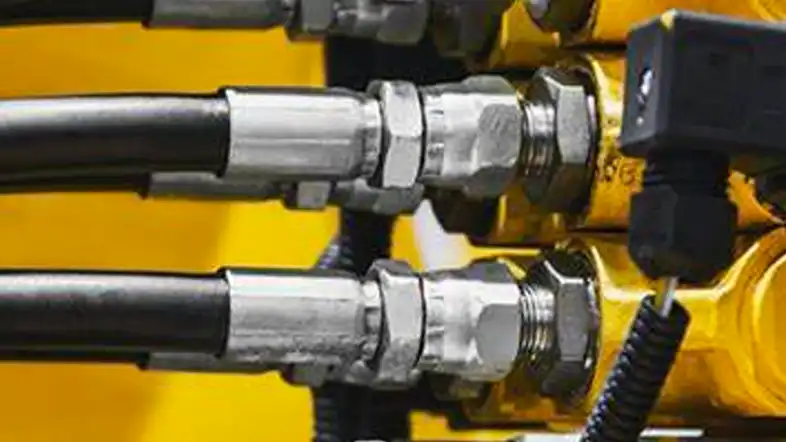
Proper maintenance of hydraulic hose couplings is crucial for the safety and longevity of a hydraulic system, preventing costly downtime and potential environmental hazards from leaks. Regular visual inspections are the most important preventative measure. You should routinely check for any signs of damage or wear and tear, and address any issues immediately.
- Regular Inspections: Visually inspect couplings for signs of corrosion, abrasion, cracks, or leaks. A small leak can quickly become a major failure, so any fluid weeping from the coupling should be investigated.
- Cleanliness: Keep couplings and their surrounding areas clean. Contaminants like dirt, debris, and moisture can compromise seals, accelerate wear, and contaminate the hydraulic fluid, leading to system damage.
- Proper Alignment and Torque: Ensure couplings are properly aligned and tightened to the manufacturer’s specifications. Over-tightening can strip threads or damage seals, while under-tightening can lead to leaks and blow-outs.
- Use Protective Caps: When hydraulic hoses are disconnected, use protective caps or plugs to prevent dirt and other contaminants from entering the open ends of the couplings and the hydraulic system.
- Monitor System Conditions: Be aware of the system’s operating pressure and temperature. Exceeding the recommended ratings can put undue stress on the couplings and lead to premature failure.
How to Expand the Lifespan of Hydraulic Hose Couplings
Expanding the lifespan of hydraulic hose couplings requires a proactive approach that goes beyond basic maintenance. It starts with proper selection and installation and continues with vigilant monitoring of operating conditions and environmental factors. By addressing these key areas, you can significantly extend the service life of your couplings and the entire hydraulic system.
- Proper Selection: Choose hydraulic hose couplings that are specifically rated for the pressure, temperature, and fluid type of your application. Using the correct material and size from the outset prevents premature wear and failure.
- Correct Installation: Ensure that couplings are installed according to the manufacturer’s specifications, including proper crimping and alignment. Improper installation can create undue stress, leading to leaks, abrasion, and catastrophic failure.
- Protect from Abrasion and Damage: Route hydraulic hoses and couplings away from sharp edges, moving parts, or surfaces where they can rub. Use protective sleeves, spiral wrap, or guards to shield them from physical damage and harsh environmental conditions.
- Monitor Operating Conditions: Continuously monitor the system’s pressure, temperature, and fluid quality. Operating within the recommended limits and promptly addressing pressure spikes, overheating, or fluid contamination will prevent internal and external degradation of the couplings.
- Maintain Cleanliness: Keep couplings, hoses, and the hydraulic fluid clean. Contaminants like dirt and debris can damage seals, clog components, and accelerate wear. Use protective caps when couplings are disconnected and ensure a clean environment during maintenance.
Conclusion
Hydraulic hose couplings are integral components in hydraulic systems, providing secure connections and ensuring the efficient flow of hydraulic fluid. By understanding the different types of couplings, considering important factors when selecting them, and following proper installation and maintenance practices, you can maximize the performance, safety, and longevity of your hydraulic system.
Incorporating regular inspections, addressing leaks promptly, and adhering to best practices for maintenance will help extend the lifespan of hydraulic hose couplings, ultimately saving costs and improving overall system reliability.

